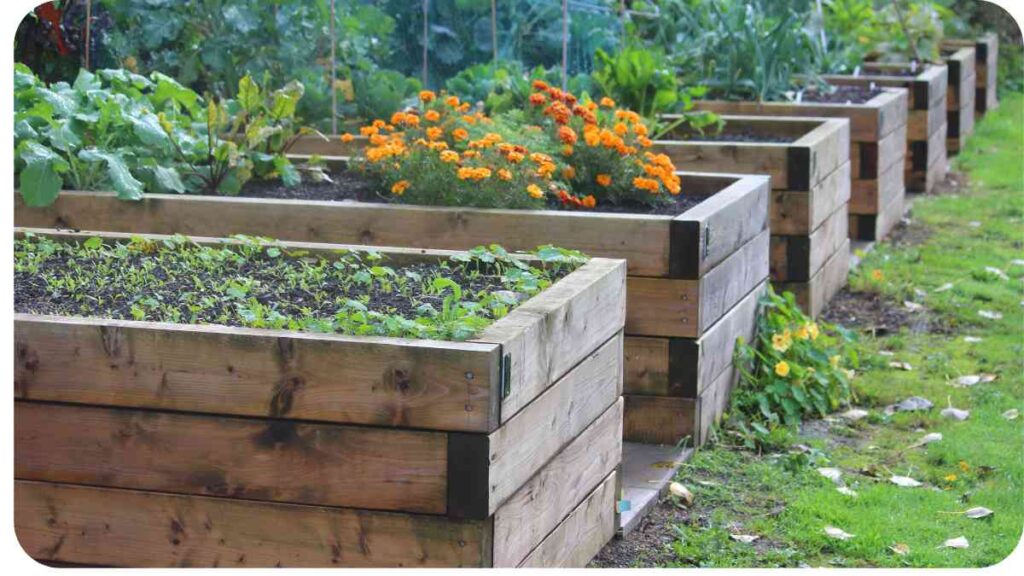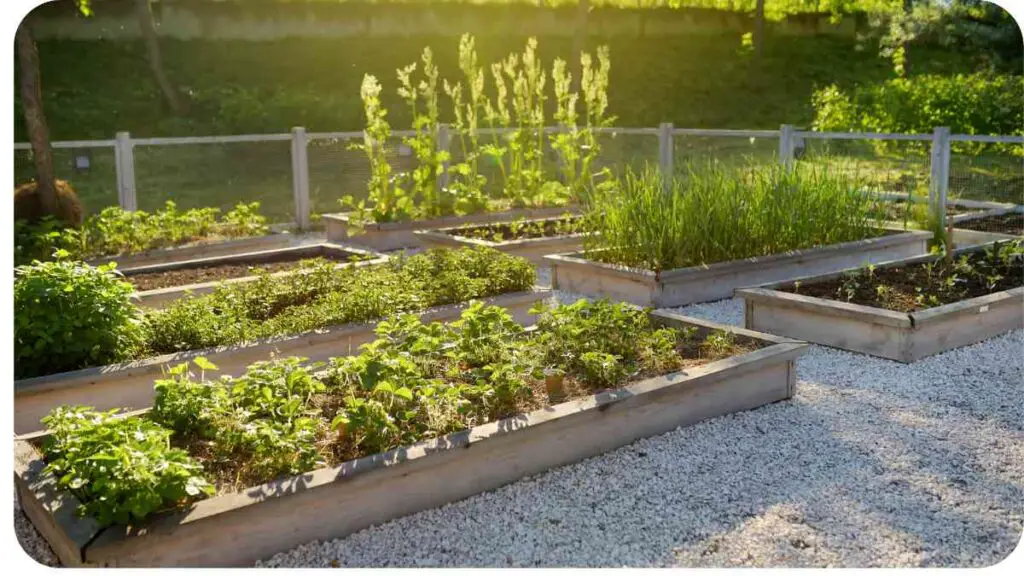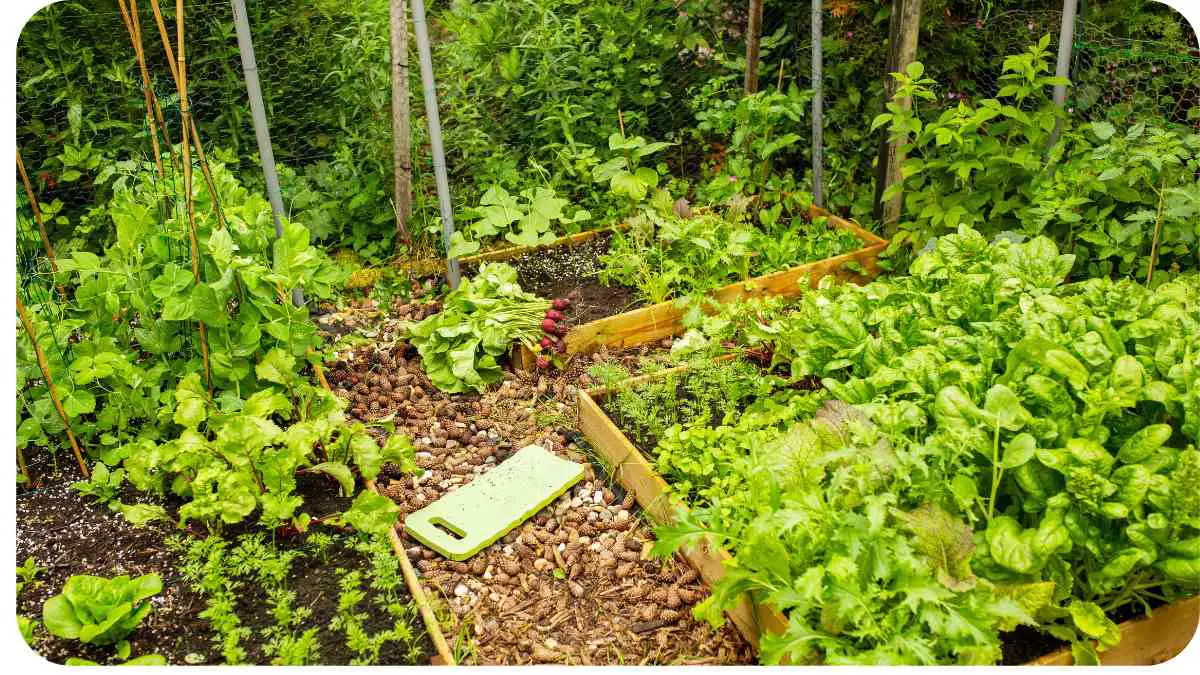Welcome to the world of gardening, where you cultivate beautiful landscapes and vibrant flowerbeds. However, there’s one problem that can dampen your green dreams: soggy garden beds. In this comprehensive guide, we’ll explore the reasons behind poor soil drainage and provide you with expert solutions to turn your waterlogged garden into a thriving oasis.
| Takeaways |
| Proper soil drainage is crucial for healthy gardens. |
| Recognize signs of poor drainage, such as waterlogged areas and stunted plant growth. |
| DIY solutions like raised beds, soil amendment, and French drains can improve drainage. |
| Choose the right plants that tolerate moisture for soggy areas. |
| Consider professional help and subsurface drainage systems for severe issues. |
| Eco-friendly solutions like rain gardens and native plants promote sustainability. |
| Preventative measures include proper grading, watering techniques, and aeration. |
| Regular maintenance and fall clean-up are essential for long-term garden health. |
| Learn from a real-life case study to see practical solutions in action. |
| Avoid common mistakes, including ignoring drainage problems and planting unsuitable species. |
2. Understanding Poor Soil Drainage
Before we dive into solutions, let’s understand the root cause of soggy garden beds. Soil drainage issues often stem from a combination of factors such as compacted soil, clay content, and improper grading. These factors hinder water from moving away from plant roots effectively.
When it comes to achieving sustainable landscaping, it’s important to understand the principles involved. Check out these insights on sustainable landscaping to get started with eco-friendly gardening practices.
3. Signs of Soggy Garden Beds

How do you know if your garden has drainage problems? Look out for signs like waterlogged areas, stunted plant growth, and a musty smell. Recognizing these symptoms early can save your plants from drowning.
4. The Importance of Proper Soil Drainage
Proper soil drainage is essential for healthy plant growth. Without it, roots can suffocate, and plants may rot from excessive moisture. As an experienced gardener, I’ve seen the detrimental effects of poor drainage firsthand.
5. Assessing Your Garden’s Drainage
Before implementing solutions, assess your garden’s drainage. This step-by-step evaluation can help you pinpoint the areas that need attention. Consider creating a table to track your findings:
| Garden Area | Drainage Issue | Severity | Solution Required |
| Front Yard | Water pooling | High | French Drain |
| Backyard | Slow runoff | Medium | Soil Amendment |
| Side Garden | Soggy soil | Low | Raised Beds |
6. DIY Soil Drainage Solutions
Now that you’ve assessed your garden’s drainage, let’s explore some do-it-yourself solutions to combat soggy soil.
“Enhance your garden with the must-have landscaping plants that elevate its charm. From vibrant flowers to lush shrubs, these essential plants will transform your garden into a paradise of colors and scents.
6.1. Raised Beds
One effective solution is to create raised beds. These elevated garden plots provide excellent drainage by allowing excess water to flow out of the bed. Share your experience and expertise:
In my gardening journey, I’ve found that raised beds are a game-changer. They elevate your plants above the waterlogged soil, ensuring their roots stay dry and healthy. I constructed wooden frames and filled them with well-draining soil mix to create my raised beds. It not only improved drainage but also made gardening more accessible.
6.2. Amending Soil
Soil amendment is another DIY approach. You can enhance your soil’s drainage by adding organic matter like compost or peat moss. This improves soil structure and water absorption. Have you tried this technique?
Amending soil has been a crucial part of my gardening routine. Mixing organic matter into the soil helps break up compacted areas and allows water to infiltrate easily. I recommend adding compost in the early spring and again in the fall to keep your soil in prime condition.
Create a low-maintenance haven by exploring creative ideas for your outdoor space. Discover smart design strategies and plant choices that result in a stunning garden, requiring minimal effort to maintain its beauty.
6.3. French Drains
French drains are underground drainage systems that divert excess water away from your garden. It’s a bit more involved but highly effective. Share your insights:
French drains are a go-to solution for me when dealing with severe drainage problems. I’ve installed a few in my backyard. It involves digging a trench, laying down gravel and perforated pipes, and covering it with soil. This system efficiently directs water away from the garden, keeping it dry.
6.4. Permeable Pathways
Don’t forget about pathways. Permeable materials like gravel or permeable pavers allow water to seep through rather than pooling on the surface. Have you considered this for your garden?
I revamped my garden pathways with permeable materials. It not only solved drainage issues but also added a charming touch to the landscape. The water now soaks into the ground instead of creating puddles, and my plants are thriving.
Save water and embrace sustainability with innovative xeriscaping ideas. Explore water-saving techniques and creative landscape designs, ensuring your garden remains lush and vibrant even in water-challenged environments.
7. Choosing the Right Plants
Selecting the right plants is crucial for a garden with drainage issues. Opt for species that thrive in moist conditions, such as water-loving perennials and wetland natives. Share your expertise:
When dealing with poor drainage, plant selection is paramount. I’ve had great success with plants like astilbes, irises, and Japanese maples in my soggy areas. They not only tolerate moisture but also add aesthetic appeal to my garden.
8. Professional Help and Drainage Systems
In some cases, DIY solutions may not be sufficient. It’s wise to consider professional help and drainage systems to ensure a lasting fix.
8.1. Drainage Contractors
Experienced drainage contractors can assess your garden’s needs and recommend tailored solutions. Their expertise can save you time and effort in the long run.
When I faced a particularly stubborn drainage issue, I consulted a drainage contractor. Their insights and professional-grade solutions made a significant difference. They installed a subsurface drainage system that worked wonders.
“Maximize your garden’s potential by choosing the right plants for a thriving, water-wise landscape. With these xeriscaping tips, you can create a visually appealing garden that conserves water and promotes sustainable gardening practices.
8.2. Subsurface Drainage Systems
Subsurface drainage systems, like the one I mentioned, are engineered to perfection. They consist of pipes, drains, and pumps that efficiently redirect water away from your garden.
Subsurface drainage systems are like hidden heroes of the gardening world. They discreetly whisk away excess water, leaving your garden dry and flourishing. Remember, a well-planned system can be a game-changer.
9. Seasonal Maintenance
Your work isn’t done once you’ve fixed the drainage issue. Proper maintenance is essential to keep your garden beds in prime condition.
9.1. Fall Clean-Up
Fall clean-up is essential. Remove fallen leaves and debris that could block drainage pathways.
Every autumn, I make it a point to clean up my garden thoroughly. It ensures that water can flow freely and reduces the risk of clogs.
9.2. Mulching
Mulching is both a preventive and maintenance measure. It regulates soil temperature, retains moisture, and reduces erosion.
Mulching has been a lifesaver for my garden. It keeps the soil from becoming overly saturated during heavy rains and helps retain moisture during dry spells.
9.3. Regular Soil Testing
Regular soil testing helps you monitor your garden’s health. It allows you to adjust pH levels and nutrient content as needed.
Soil testing is my secret weapon for maintaining a healthy garden. By knowing the soil’s composition, I can make informed decisions about amendments and fertilizers.
10. Eco-Friendly Drainage Solutions
Incorporate eco-friendly solutions into your garden to promote sustainability and reduce environmental impact.
10.1. Rain Gardens
Rain gardens are eco-friendly and visually appealing. They capture and filter rainwater, preventing runoff and erosion. Share your thoughts:
Rain gardens are a fantastic way to harness the power of rainwater. I’ve designed a beautiful rain garden in my backyard, featuring native plants. It not only helps with drainage but also supports local wildlife.
10.2. Rain Barrels
Rain barrels collect rainwater from gutters for later use in your garden. It’s a sustainable way to manage excess moisture. Have you tried using rain barrels?
Rain barrels are a great addition to any garden. I’ve connected them to my downspouts, and the collected rainwater is a valuable resource during dry spells. Plus, it reduces runoff into storm drains.
10.3. Native Plants
Native plants are adapted to your region’s natural conditions, including local drainage patterns. Incorporating them into your garden can help with moisture management.
I’ve come to appreciate the value of native plants. They’ve evolved to thrive in my area’s specific conditions, including drainage. They require less maintenance and help maintain the ecological balance.
11. Preventative Measures
Prevention is often the best cure. Consider these preventative measures to keep drainage issues at bay.
11.1. Sloping the Landscape
Ensure your garden slopes away from your house and toward drainage areas. This simple adjustment can prevent water from pooling near your foundation.
Sloping my garden away from my house was a game-changer. It prevents water from seeping into my basement and keeps my garden beds well-drained.
11.2. Proper Watering Techniques
Overwatering can exacerbate drainage issues. Water your plants deeply but less frequently to encourage healthy root growth.
It’s easy to overwater, especially when you’re worried about drainage. I’ve learned to water deeply but less often. This encourages plants to develop deeper roots, which can access water even in damp soil.
11.3. Aeration
Regularly aerating your soil can improve its structure and drainage. Consider using a garden fork or aerator to break up compacted areas.
I make a point of aerating my soil every spring. It’s a small effort that goes a long way in improving drainage and overall soil health.
12. Case Study: Transforming a Soggy Garden

Let’s delve into a real-life case study to see how these solutions can make a significant impact. In this scenario, I transformed a waterlogged garden into a thriving oasis.
Problem: The backyard garden had severe drainage issues, resulting in water pooling around plants, root rot, and unhappy gardeners.
Solution: I took a multi-pronged approach to address the problem.
- Raised Beds: I constructed raised beds using cedar planks. This elevated the plants above the problematic soil, ensuring their roots stayed dry.
- French Drain: To tackle the persistent water pooling, I installed a French drain along the lowest edge of the garden. This channelled excess water away effectively.
- Proper Plant Selection: I chose water-loving plants like irises, ferns, and Joe Pye weed for the low-lying areas, while planting drought-resistant species on elevated beds.
- Mulching: Applying a generous layer of mulch around the plants helped retain moisture while preventing weeds.
Result: The transformation was remarkable. The garden went from a soggy mess to a vibrant, lush paradise. The plants thrived, and the once-waterlogged areas became a showcase of beautiful wetland flora.
13. Common Mistakes to Avoid
To ensure your garden’s success, here are some common mistakes to avoid:
- Ignoring Drainage: Neglecting drainage issues can lead to long-term damage. Address them promptly.
- Overcomplicating: While professional help can be essential, don’t overcomplicate solutions. Sometimes, a DIY approach is sufficient.
- Planting Unsuitable Species: Planting the wrong types of plants for your garden’s conditions can lead to continuous drainage problems.
- Neglecting Maintenance: Regular maintenance is key to preventing drainage issues from returning.
14. Conclusion
In your journey to conquer soggy garden beds, remember that with the right knowledge, experience, and a bit of elbow grease, you can transform your garden into a flourishing oasis. From DIY solutions to professional help and eco-friendly options, you have a range of tools at your disposal. Don’t let poor drainage dampen your gardening dreams; take action today and watch your garden thrive.
Remember, the key to success lies in understanding your garden’s unique needs and continually working to maintain its health and beauty. Happy gardening!
Further Reading
Here are some additional resources to explore for further information on improving garden drainage:
- Better Homes & Gardens – Improve Poor Drainage: This comprehensive guide from Better Homes & Gardens offers practical tips and solutions for enhancing garden drainage.
- House Beautiful – Garden Drainage: House Beautiful provides insights into garden drainage issues and how to tackle them effectively.
- Marc Doyle Tree Work – 6 Simple Ways to Fix Poor Garden Drainage: Learn about straightforward methods to address poor garden drainage from the experts at Marc Doyle Tree Work.
FAQs
What causes poor drainage in garden beds?
Poor garden drainage can be caused by factors like compacted soil, high clay content, improper grading, and blocked drainage pathways.
How can I assess the drainage in my garden?
To assess garden drainage, look for signs of waterlogging, slow runoff, or standing water. You can also perform a simple soil percolation test.
Are there eco-friendly solutions for garden drainage issues?
Yes, eco-friendly solutions like rain gardens, rain barrels, and native plant selection can help manage excess moisture sustainably.
Can I improve garden drainage with DIY methods?
Yes, you can improve garden drainage through DIY methods like raised beds, soil amendment, and French drains. These solutions are often effective and cost-efficient.
When should I consider professional help for garden drainage problems?
If DIY solutions don’t resolve the issue or if you have severe drainage problems, it’s advisable to consult a drainage contractor or consider subsurface drainage systems.

Hi! My name is Hellen James, and I’m a landscape designer in Los Angeles. I’ve been working with homeowners and businesses to help them improve the look of their properties for over 10 years.


